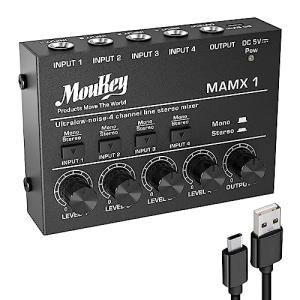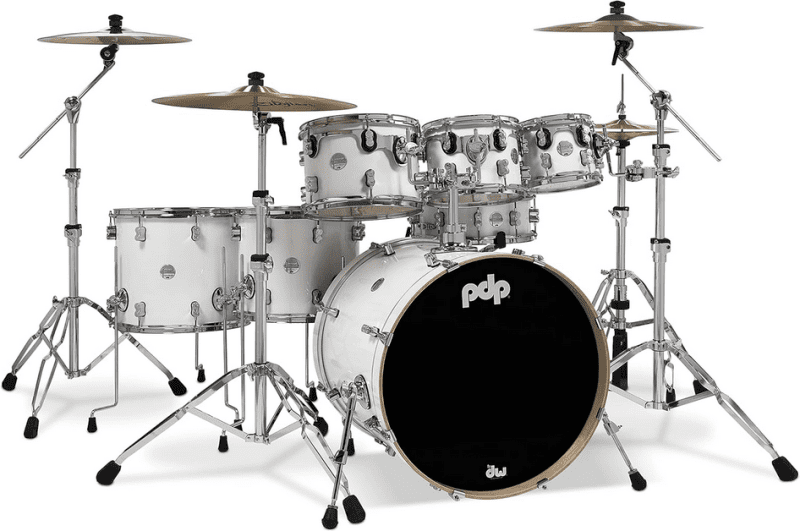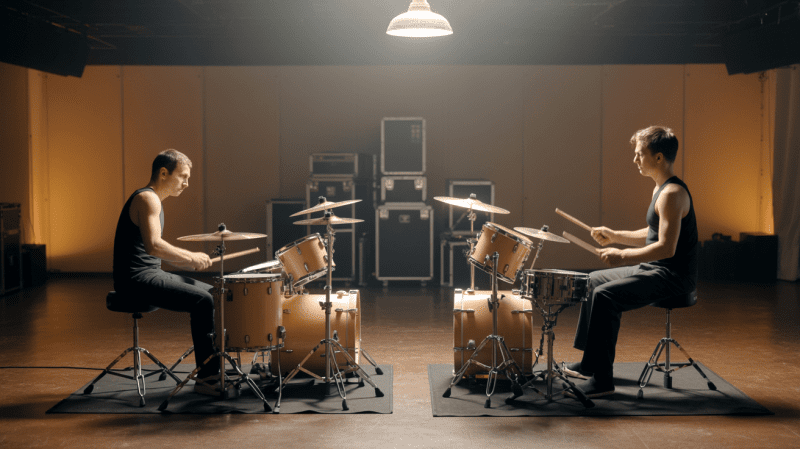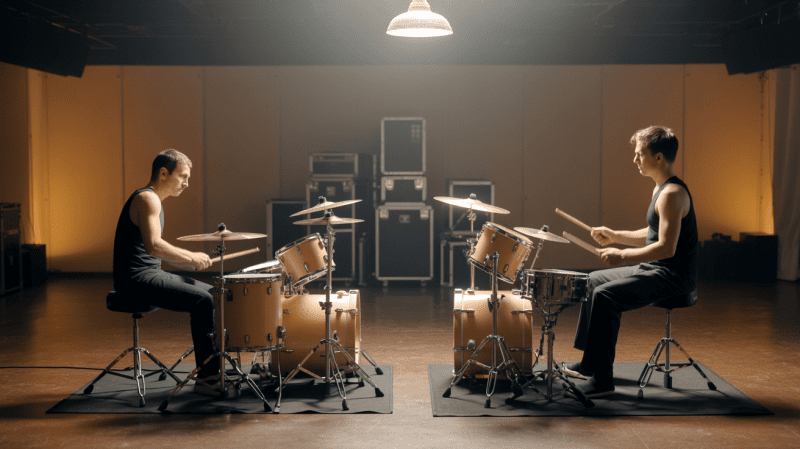Recording drums can be tough but rewarding for an engineer. The drum kit's size and sounds can be intimidating, especially for beginners. Preparation is key - the right drum kit, space, and gear are vital for a good drum sound. Where you place the kit matters too. A room with good acoustics can enhance the sound without extra effects. Many pros choose studios with excellent drum room sound.
Key Takeaways
- Proper drum kit preparation, including tuning and dampening, lays the foundation for a successful recording session.
- The recording environment, from the size and acoustics of the room to the choice of studio, can significantly impact the final drum sound.
- Multi-miking techniques, such as close miking, overhead miking, and room miking, allow engineers to capture a well-rounded and dynamic drum sound.
- Understanding phase coherence and bleed control is crucial when using a variety of microphones to record drums.
- Careful microphone selection and placement are essential for achieving the desired drum tone and character.
Introduction to Drum Recording
Drums are key in music, creating the base and rhythm of a song. Recording them is both rewarding and tough. It needs planning and skill to catch their dynamic, powerful sound accurately.
Importance of Drums in Music Production
Drums are vital in music, setting the groove and energy. They make the song's solid rhythm, letting other instruments join in. This builds a strong, lively music piece.
Challenges and Rewards of Recording Drums
The drum kit's size and loudness, plus its many sounds, can be scary for engineers. But, knowing where to put mics, how to deal with noise, and using room sound well can help. This way, you can keep the drum's energy in your music, making it rich and powerful.
https://www.youtube.com/watch?v=cFXqcEtyWkA
Preparing the Drum Kit
The drum kit you choose really matters for the sound you want to get when you record. Knowing the sound you want makes picking the right drum kit easier. It's also key to have the drums in top shape and well-tuned before you record.
Choosing the Right Drum Kit
Tuning the drums well is a big deal in getting ready. It helps the engineer a lot. You can use a drum dial to tune each drum head spot on. This gives you an even tone throughout the kit. Also, putting moongels or similar materials on the drums can cut down on the noise. This way, you get a crisper, more exact drum sound.
Tuning and Dampening the Drums
Selecting the best drum kit, then tuning and dampening it, is the start of good drum recordings. When the drums are all set, audio engineers can put their focus on mic placement, controlling bleed, and other critical recording steps.
Selecting the Recording Space
The room for drum recordings is very important. A
large, reflective space with high ceilings and hard surfaces, such as brick, wood, or stone
, is the best. It lets the drums sound full and natural. Famous studios are famous for their drum rooms. These spaces make the drums sound unique and alive.
Characteristics of a Good Drum Room
Yet, not everyone can use such big, perfect rooms. If you're stuck with a
small, carpeted room
, there are tricks. You can make simple changes to get a clear drum sound. The key is to work with what you have, smartly.
Unique Recording Spaces
Some engineers think beyond traditional studios. They find great spots like old warehouses or churches. These places add special qualities to the drum sound. They offer a chance to create something truly different.
https://www.youtube.com/watch?v=8DAqAvLUkU0
drum recording techniques
Drum recording has three main methods: close, overhead, and room miking. Each method offers different benefits when recording the powerful sound of drums. Close miking focuses on individual drum elements, like the kick or snare, for a clear, punchy sound. Overhead miking captures the entire drum kit from above, creating a natural, ambient drum sound. Room miking places mics around the room to catch its natural sound, adding depth and ambience to the drum recording.
Close Miking Techniques
Close miking is all about putting mics close to each drum. This captures the pure, direct sound of the drum. It lets us control and perfect the sound of each drum. It's great for making sure drums sound just right in a mix.
Overhead Miking Techniques
With overhead miking, we place mics above the drum kit. This technique records the full kit's sound, reflecting its natural balance. It picks up the interaction between different drums and cymbals. Plus, it includes the room's acoustics. This gives us the true, full drumming experience.
Room Miking Techniques
Room miking adds spread and depth to the drum sound. We put mics around the room to get its natural feel. It captures the drum sound as if the listener is right there in the room. This method, along with close and overhead miking, creates a complete, layered drum recording.
When using several mics together, like with close, overhead, and room miking, we must watch for phasing and sound bleed. Handling these issues well makes a well-balanced, professional drum recording. It lets sound engineers craft the perfect drum sound for the music.
Conclusion
Recording drums well takes understanding and attention to detail. You must get the drum set ready and pick the right microphones. How you set up and record each part is key for a great drum sound.
Factors like the room's sound, keeping the sound clear, and stopping sounds from mixing are important. They help make the drum sound powerful yet clean in music products.
Making drums sound amazing is not easy, but it's very rewarding. The drums can really shape how a song feels. Knowing how to record drums opens up creative possibilities for engineers.
Whether you muffle the sound up close, use mics above, or just record the room, it's about knowing what works best. This means understanding how each recording step and mic position affects the sound.
Success in drum recording is about a balance. This balance mixes tech knowledge with creative vision. Engineers should always be learning to keep improving, making the drums in their recordings stand out.
FAQ
What are the key considerations when recording drums in the studio?
Recording drums well takes a lot of prep work. It involves picking the best drum kit and making sure the drums are well-tuned and quiet. You need a good room to record, with the right sound qualities. The sound engineer also has to think about where to put the microphones. They should avoid issues with sound interference and make sure each drum sounds clear and strong.
How does the choice of drum kit impact the recorded sound?
The drums, cymbals, and other parts of the kit are very important. If they're not in good shape or not tuned well, it can spoil the recording. Choosing the best equipment and keeping it in top condition are key for a fantastic drum recording.
What role does the recording room play in shaping the drum sound?
Where you record the drums matters a lot. A big room with hard walls and a high ceiling is best. This kind of room helps the drums sound big and natural. But sometimes, you can't pick the perfect room. In those cases, working with what you have is essential to still get a good sound.
What are the main drum recording techniques, and how do they differ?
There are different ways to record drums. Close miking focuses on each drum to get a strong, forward sound. Overhead miking captures the drums in a more natural way. It's like you're standing near the drum set. Room miking makes the drums sound big by picking up the sound of the room itself.
How do engineers ensure phase coherence and control bleed when using multiple microphones?
When using lots of microphones, making sure they work well together is important. Engineers focus on where they place each microphone. This helps avoid problems with the sound of the drums mixing in a bad way. They work to make sure the drums sound clear and not messy.
What techniques can be used to shape the drum sound during the mixing process?
In the mixing stage, there are tools to make the drums sound even better. Compression, gating, EQ, and other effects can enhance the sound. They can make the drums sound less noisy, keep them in control, and make them stand out in the music.
How can engineers overcome challenges in drum recordings, such as a less-than-ideal recording space?
Even in a not-so-great room, you can get a good drum sound. Engineers use tricks like adding reflective surfaces and changing where they put the microphones. These tricks help to make the drums sound direct and clear. Being able to adapt to different spaces is a must for any good sound engineer.





